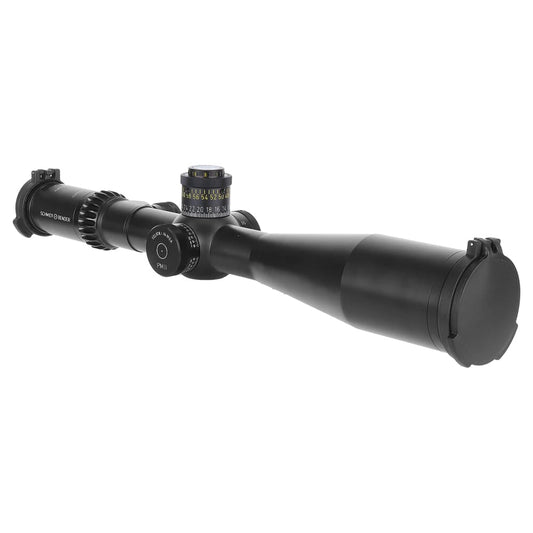

Schmidt Bender PM II 5-25x56mm Riflescope LP P4FL is engineered for high precision and adaptability in various shooting environments. With a magnification range of 5-25x, this scope provides clear visibility for long-distance shooting, making it suitable for competitive shooters and law enforcement alike. The first focal plane design allows the reticle to maintain its size relative to the target, facilitating accurate ranging at all magnifications. Its robust construction and matte black finish ensure resilience against harsh conditions.
Equipped with an illuminated P4FL reticle, this riflescope enhances target visibility in low-light settings, while advanced turret adjustments ensure reliable and repeatable point of impact shifts. The parallax adjustment capability from 10 meters to infinity supports parallax-free shooting, further improving accuracy. Designed for optimal performance, the Schmidt Bender PM II 5-25x56mm combines quality optics with user-friendly features, making it an exceptional choice for hunting enthusiasts and precision shooters.
Features – Key Benefits Bullets
- LONG-RANGE VISIBILITY: The 5-25x magnification range allows for detailed visibility over long distances, making it ideal for precision shooting where clear target identification is critical.
- PRECISION OPTICS: Featuring a first focal plane P4FL reticle, this riflescope maintains the proportion of the reticle to the target across the entire zoom range, ensuring pinpoint accuracy.
- ILLUMINATED RETICLE: With an illuminated reticle, the scope enhances reticle visibility against dark targets or in low light conditions, crucial for a clear point of aim.
- ROBUST CONSTRUCTION: The riflescope's durable 34mm tube is finished in matte black, offering superior resistance to the elements and rough handling in any shooting environment.
- ADVANCED TURRETS: Precision-engineered .1 MRAD click adjustments on both elevation (DT) and windage (ST) turrets offer reliable and repeatable point of impact shifts for accurate shooting.
- PARALLAX FREE: The adjustable parallax from 10 meters to infinity allows for parallax-free shooting, ensuring the reticle and target do not shift relative to each other.
- OPTIMAL EYE RELIEF: Generous eye relief provides a comfortable viewing distance from the eyepiece, reducing eye strain and allowing for quick target acquisition.
- TWILIGHT PERFORMANCE: The scope's high twilight factor ensures optimal light transmission during dawn and dusk, enhancing visibility in the most challenging lighting conditions.
Technical Specifications
| Feature | Specification |
|---|---|
| Weight | 37.57 oz |
| Length | 16.54 inches |
| Magnification Range | 5-25x |
| Objective Diameter | 56mm |
| Tube Size / Mount | 34mm |
| Turret Adjustment | .1 MRAD |
| Elevation Turret | 26 MRAD, DT |
| Windage Turret | ± 6MRAD, ST |
| Parallax Adjustment | 10m to ∞ |
| Reticle Position | First Focal Plane |
| Reticle Details | P4FL |
| Field of View | 5.3–1.5m/100m |
| Exit Pupil | 11.0–2.3mm |
| Eye Relief | 90mm |
| Twilight Factor | 15.8 - 31.6 |
| Illuminated Reticle | Yes |
| Finish | Matte Black |
| Turret Rotation | Counter Clockwise |
| UPC | 191992065228 |
| MPN | 689-911-972-90-68 |
What's in the Box?
- Schmidt Bender PM II 5-25x56mm Riflescope
- Protective Lens Caps
- Lens Cleaning Cloth
- User Manual
- Warranty Information
Customer Reviews
"The clarity and precision of this scope are unmatched. Perfect for long-range shooting!"
"I love the illuminated reticle—makes hunting in low light so much easier!"
"Built like a tank and performs flawlessly. Highly recommend for serious shooters."
FAQ
How does the Schmidt Bender PM II 5-25x56mm perform in low-light conditions?
This riflescope features an illuminated reticle and high twilight factor, ensuring optimal visibility at dawn and dusk. This is particularly beneficial for hunting in challenging lighting conditions.
What maintenance is required for this scope?
Regular cleaning of the lenses with a soft cloth is recommended to maintain clarity. Ensure that the turret adjustments are kept clean and free from debris to ensure precise operation.
How does this scope compare to other tactical scopes?
While many tactical scopes may offer similar features, the Schmidt Bender PM II is known for its robust construction, precise adjustments, and high-quality optics, making it a preferred choice for professional and competitive shooters.
Similar Models
Looking for more options? Explore our complete Schmidt Bender collection, including models like the Schmidt Bender PM II 3-12x50mm for versatile magnification and the Schmidt Bender 10-50x56mm for extreme long-range capabilities. Discover the perfect riflescope tailored to your shooting needs.
You May Also Like
Here’s some of our most similar products people are buying. Click to discover trending style.










